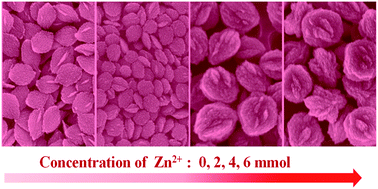Hetero-metal cation control of CuO nanostructures and their high catalytic performance for CO oxidation†
Abstract
A controllable synthesis of various morphologies of CuO nanostructures with tuning by hetero-metal cations has been developed in aqueous solution at room temperature. The morphologies of CuO can be engineered from nanosheets to nanoparticles with different length ratios of the long axis to the short axis. The formation of many metal–ion complexes plays an important role in slowing the release rate of OH− and affects the reaction kinetics further. We found that the effect of hetero-metal cations on the final morphology of the CuO nanostructures was the same as that of the cooling temperature. A series of temperature-controlled experiments demonstrated this. Furthermore, among all the synthesized CuO nanostructures, the fascinating colloidal mesoporous CuO quasi-monocrystalline nanosheets prepared at 25 °C with a thickness of ca. 10 nm and large specific surface area of 80.32 m2 g−1 is investigated intensively. These CuO nanosheets demonstrate a superior catalytic activity for CO oxidation, with features of high CO conversion efficiency (47.77 mmolCO g−1CuO h−1 at 200 °C), which is close to that reported for previously investigated supported-CuO catalysts, and a low apparent activation energy Ea (53.3 kJ mol−1).


 Please wait while we load your content...
Please wait while we load your content...